- Home Page
- Kiddy Kites
- Child Flying Kite
"Child Flying Kite" Photos
A Small Child's Kite-Flying Career
Our "child flying kite" pictures cover less than seven years. However, by the end of that he had been flying kites nearly all his life!
Browsing through our archive of kite-flying pictures, I found a number that featured our son, Aren. He was still shorter than most of his friends, in the last photo, but has now out-grown his dad—which didn't take a lot of doing.
The images did bring back a few memories, so I've captioned each shot with a comment or two. See how he graduates from waving around a small sled kite (while sitting down) through to hanging onto some of our much bigger Dowel Series kites. We hope you enjoy them.
Oh, by the way, I have deliberately avoided reusing existing photos from this site. Almost all the "child flying kite" images on this page have not been previously published on this website.
On this site, there's more kite-making info than you can poke a stick at. :-)
Want to know the most convenient way of using it all?
The Big MBK E-book Bundle is a collection of downloads—printable PDF files which provide step-by-step instructions for many kites large and small.
Every kite in every MBK series.
These captioned photos are in ascending date order, from top to bottom.
Zigzag your way down the page, starting top-left:
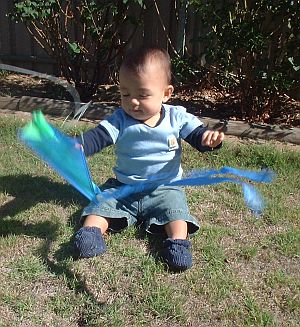
In April 2007 we took Aren outside for a short photo-session with the Baby Sled. We had bought him this kite at the Adelaide International Kite Festival in March 2007. Cuteness personified. Aren, that is, although the kite's not bad either!
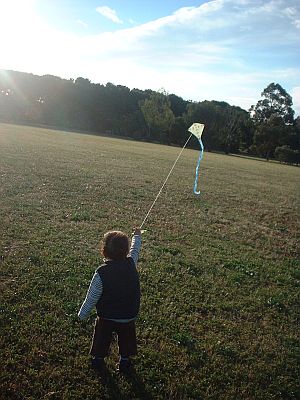
A little later in October, we had made a small diamond for Aren. Later, I simplified this design when I published the Tiny Tots diamond page.
There's Aren, barely capable of standing and flying a kite. He was very cute. Shortly after this shot was taken, he trotted off downwind, still clutching the line as the kite soared up higher in a gust of wind.
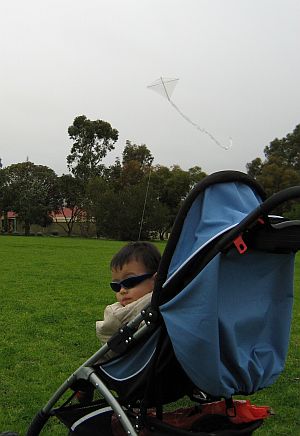
In July 2008 I took this shot of Aren flying the 1-Skewer Diamond from his pram. Of course, he had to crane his neck around, trying to see what I was up to behind the pram! It was an unintended pose, but this child flying kite picture works quite well, don't you think?
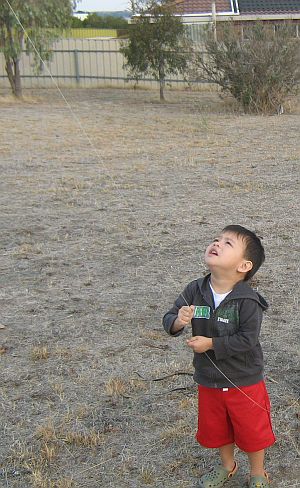
In April 2009, we were out test-flying the new Dowel Rokkaku. The wind was very light, so I allowed Aren to fly it for a few moments while I took the photo. Just look at that steep line-angle!
However, we were at the rather small vacant block at the top of our street and so had only 15 or 20 meters (60 feet) of line out. This rok has a wingspan of 1.2 meters (4 feet).
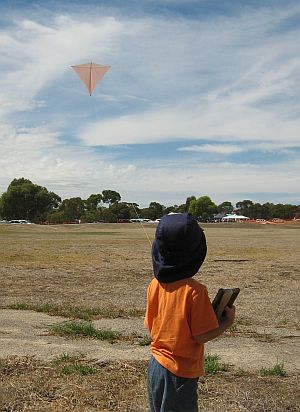
A fairly big diamond is in the air this time, in March 2010. Aren is letting it climb away slowly in very light air.
It doesn't take much to get this kite airborne, and it will even go overhead if there is any rising air around. Its pull is light enough for most child-flying scenarios, even as wind strength creeps into the moderate range.
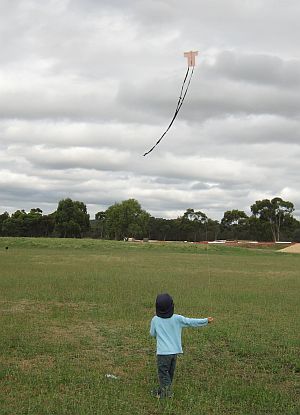
Here is Aren doing his best to keep the little 1-Skewer Sode in the air. The breeze was light and quite turbulent due to a grove of trees just upwind of us. However, I wanted to get the kite into this "child flying kite" shot so brought it down low before handing over to Aren.
This was in December 2010. The tiny sode really needs that long tail, which probably disgusts any Japanese kite masters reading this page.
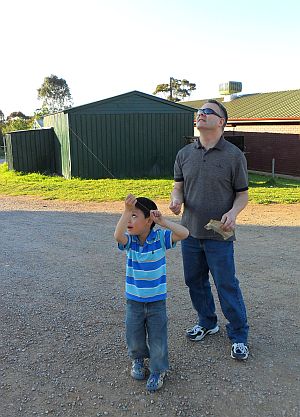
Somehow Aren's left eye is fairly prominent in this shot, adding some interest to the middle of the photo. We were testing out a 1-Skewer Dopero at the time (in a moderate breeze) in a small gravel car-park. This was sometime in September 2011.
Tiny kites don't require much space to fly. This was the third version of this design that we built as part of a general update of the 1-Skewer kite pages on this site.

By October 2007, we had bought the Windjam Delta. In those days, not knowing any better, we flew it on fishing line. Winds were light on this sunny day, and Aren had no trouble hanging on as the 1-meter delta hovered around 200 feet up.
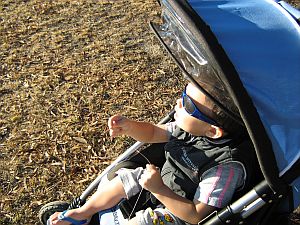
In April 2008, we snapped this shot of the little tacker flying the 1-Skewer Delta from the comfort of his pram! During the year he flew kites like this on quite a few occasions. Often, the kite was a 2-skewer design, for example the 2-Skewer Sode.
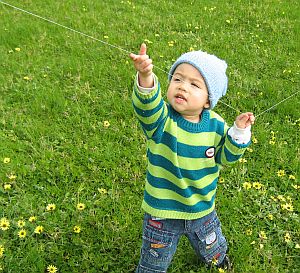
Here he is in September 2008, working the line a bit, with the 2-Skewer Delta down a little low by the looks of it! He looks like he's really enjoying himself here. No longer a human kite-line anchor, he's a real little kite-flier now!
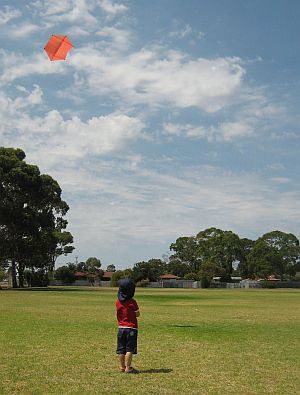
Another rok... This is February 2010. Aren is casually flying the efficient little 2-Skewer Rokkaku in ideal wind conditions.
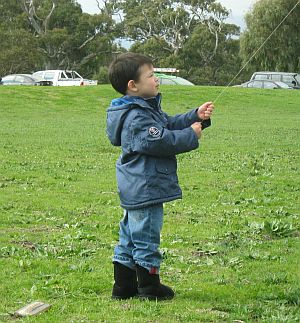
Here he is hanging on to the Dowel Barn Door in August 2010. The kite was above 200 feet at the time, so I didn't bother trying to get it in the picture.
Aren seems to be concentrating on his task! He has left the winder, with plenty of 50-pound Dacron still on it, on the grass behind him.
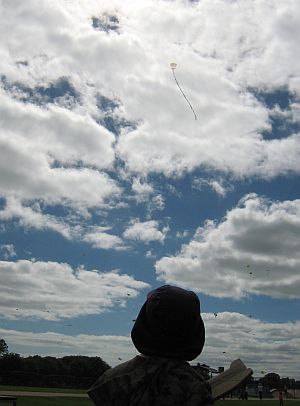
This photo was taken more-or-less facing the sun, so the tiny 1-Skewer Roller is well-lit from behind, but Aren is just a dark shadow.
The kite is dancing around on at least 30 meters (100 feet) of 20-pound Dacron line. At the time, we were on the lawns at Semaphore while attending the Adelaide International Kite Festival in March 2011.
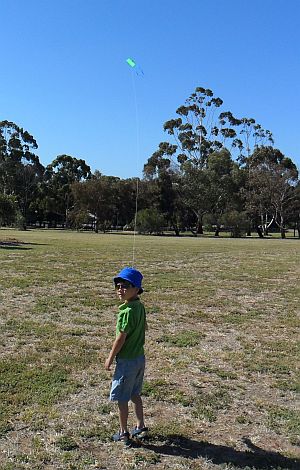
The breeze was a bit much for the venerable Baby Sled on this occasion, forcing it down low for much of the time. But Aren had fun giving it a whirl for old-time's sake! This was taken in January 2012.
If you scroll back up this page, you can see Aren as a toddler playing with this kite. It's the very first photo. The very first flight reports added to this site featured this same little kite.
A Video
Yes, that's little Aren down there, towing the MBK Tiny Tots Diamond on a cool winter day. He was about 2 1/2 years old!
I hope you enjoyed these "child flying kite" pictures! Now that Aren's age is in double digits, we'll leave it there. It's a time capsule of a by-gone era, of sorts.
As mentioned earlier, there's more kite making on this site than you can poke a stick at. :-)
Want to know the most convenient way of using it all?
The Big MBK E-book Bundle is a collection of downloads—printable PDF files that provide step-by-step instructions for many kites large and small.
That's every kite in every MBK series.
